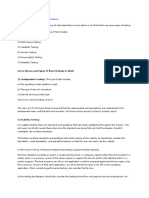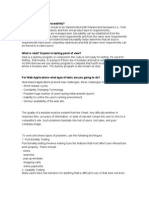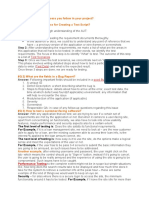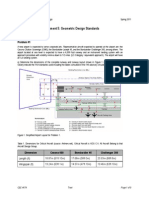Development Environment: Typically The Developer Team Will Set Up A Local Environment
Development Environment: Typically The Developer Team Will Set Up A Local Environment
Uploaded by
Rudhra MoorthyCopyright:
Available Formats
Development Environment: Typically The Developer Team Will Set Up A Local Environment
Development Environment: Typically The Developer Team Will Set Up A Local Environment
Uploaded by
Rudhra MoorthyOriginal Title
Copyright
Available Formats
Share this document
Did you find this document useful?
Is this content inappropriate?
Copyright:
Available Formats
Development Environment: Typically The Developer Team Will Set Up A Local Environment
Development Environment: Typically The Developer Team Will Set Up A Local Environment
Uploaded by
Rudhra MoorthyCopyright:
Available Formats
Penetration testing is nothing but security testing. i.
e testing the firewall and breaking the intranet is known as penetration A penetration test could focus exclusively on your web applications. This could be done at various levels Black-box testing: Here, we only know the URL of the website. Enumeration of technologies, mapping of the website, identification of fault injection points. Nothing but security testing
In the early design and development work, functional user requirements will normally get the most attention. There are modelling techniques (notations) such as the UML Use Case and Activity Diagrams, extended Function Flow Block Diagrams (eFFBD) or Behaviour Diagrams, which offer methods for depicting what operations are to be done in time sequence and the control logic that will control the flow of execution. Treatment of the non-functional user requirements may not be so straightforward. We must first look at the basic types of NFRs:
Environment requirements defining the physical environment (natural and induced) for
system operation. In some cases, they may also address the political or economic setting in which the work is done or the system performs
Physical requirements describing the form of the product or system. Examples include Interface requirements defining the data, structure and physical form of interfaces
specifying the size, shape, paint finish, weight or other similar properties of products or systems. between components (hardware, software and people). There may also be a need to interface to existing systems or provide certain standard interfaces. Some requirements analysts classify interface requirements as a separate group, not as a type of NFR.
Constraints requirements prescribing stipulations or limitations on how the system can
be built, or how and in what context should other requirements apply. Non-technical aspects such as timeline and budget can also constrain development projects.
Quality Factors (Emergent Properties) requirements that address other quality
factors of the product or process, the ilities mentioned above.
posted
Friday, February 12, 2010 12:16:55 PMFeb 11, 2010 23:46:55
0
Development environment: Typically the developer team will set up a local environment
on their machines to develop. Code developed by multiple developers will typically be maintained and synched under some version control system. Please do not ask what a version control system is. Use google. Test environment: Code developed by the developer team is combined together and built. These binaries are typically deployed on a test server/s. The QA team will use this as their test environment and run all kinds of test cases in such an environment and identify bugs Production environment: Bugs are identified, fixed, redeployed on the test environment and the cycle continues. Once a stable build has been achieved, it is rolled off for actual use, which would be a production server.
Re: In Keyword driven frame work you have write 30 test case for one scenario,in which 10 test cases are failed while executing.client asked you to execute only the failed test cases. HOw can you execute only failed test cases Answer As per my understanding on your # 1 question, in keyword driven
framework, we have driver sheet which contains all the testcases names with an indicator(Y/N). Here Mark the indicator as "Y" only for the failed 10 scripts.so that the driver script will read those testcases(which are marke as "Y") and execute those testcases. I hope this suffice your question. If there is any deviations, please let us know, we will try to provide answer. Thanks, Lakshmi
For Web Applications what type of tests are you going to do? Web-based applications present new challenges, these challenges include: - Short release cycles; - Constantly Changing Technology; - Possible huge number of users during initial website launch; - Inability to control the user's running environment; - 24-hour availability of the web site.
The quality of a website must be evident from the Onset. Any difficulty whether in response time, accuracy of information, or ease of use-will compel the user to click to a competitor's site. Such problems translate into lost of users, lost sales, and poor company image.
To overcome these types of problems, use the following techniques: 1. Functionality Testing Functionality testing involves making Sure the features that most affect user interactions work properly. These include: forms searches pop-up windows shopping carts online payments 2. Usability Testing Many users have low tolerance for anything that is difficult to use or that does not work. A user's first impression of the site is important, and many websites have become cluttered with an increasing number of features. For general-use websites frustrated users can easily click over a competitor's site. Usability testing involves following main steps identify the website's purpose; identify the indented users ; define tests and conduct the usability testing analyze the acquired information 3. Navigation Testing Good Navigation is an essential part of a website, especially those that are complex and provide a lot of information. Assessing navigation is a major part of usability Testing. 4. Forms Testing Websites that use forms need tests to ensure that each field works properly and that the forms posts all data as intended by the designer.
5. Page Content Testing Each web page must be tested for correct content from the user perspective for correct content from the user perspective. These tests fall into two categories: ensuring that each component functions correctly and ensuring that the content of each is correct. 6. Configuration and Compatibility testing A key challenge for web applications is ensuring that the user sees a web page as the designer intended. The user can select different browser software and browser options, use different network software and on-line service, and run other concurrent applications. We execute the application under every browser/platform combination to ensure the web sites work properly under various environments. 7. Reliability and Availability Testing A key requirement o a website is that it Be available whenever the user requests it, after 24-hours a day, every day. The number of users accessing web site simultaneously may also affect the site's availability. 8. Performance Testing Performance Testing, which evaluates System performance under normal and heavy usage, is crucial to success of any web application. A system that takes for long to respond may frustrate the user who can then quickly move to a competitor's site. Given enough time, every page request will eventually be delivered. Performance testing seeks to ensure that the website server responds to browser requests within defined parameters. 9. Load Testing The purpose of Load testing is to model real world experiences, typically by generating many simultaneous users accessing the website. We use automation tools to increases the ability to conduct a valid load test, because it emulates thousand of users by sending simultaneous requests to the application or the server. 10. Stress Testing Stress Testing consists of subjecting the system to varying and maximum loads to evaluate the resulting performance. We use automated test tools to simulate loads on website and execute the tests continuously for several hours or days.
11. Security Testing Security is a primary concern when communicating and conducting business- especially sensitive and business- critical transactions - over the internet. The user wants assurance that personal and financial information is secure. Finding the vulnerabilities in an application that would grant an unauthorized user access to the system is important.
You might also like
- Hirac - DoleDocument11 pagesHirac - DoleAngela Salumbides67% (3)
- Manual Testing Interview QuestionsDocument36 pagesManual Testing Interview QuestionsCorythiaNo ratings yet
- Pipelay Procedure RevisedDocument31 pagesPipelay Procedure Revisedcbsd24100% (2)
- HUAWEI BTS3900E Hardware Structure and Principle-090519-IsSUE1.0-BDocument78 pagesHUAWEI BTS3900E Hardware Structure and Principle-090519-IsSUE1.0-BJaime Ambaco Matsena100% (1)
- Non Functional Testing of Web Applications: Let Us Discuss Each Types of These Testings in DetailDocument9 pagesNon Functional Testing of Web Applications: Let Us Discuss Each Types of These Testings in Detailneovik82100% (1)
- Website TestingDocument13 pagesWebsite TestingMilindraj DeoleNo ratings yet
- What Is Bidirectional Traceability?: Manual Testing A&QDocument73 pagesWhat Is Bidirectional Traceability?: Manual Testing A&QArvind Vijayan PillaiNo ratings yet
- Manual - Testing - Interview - Q&A 2024 MayDocument41 pagesManual - Testing - Interview - Q&A 2024 Maymahesh7404No ratings yet
- Performance Testing: Performance Testing Is Performed To Evaluate ApplicationDocument21 pagesPerformance Testing: Performance Testing Is Performed To Evaluate ApplicationVivek ShawNo ratings yet
- Manual Testing Job Interview Preparation GuideDocument11 pagesManual Testing Job Interview Preparation GuideAshok MuraliNo ratings yet
- Web Application TestingDocument8 pagesWeb Application TestingNae EmanuelaNo ratings yet
- What Is Bucket TestingDocument20 pagesWhat Is Bucket TestinghsesidNo ratings yet
- WE AssignmentDocument5 pagesWE AssignmentAbdul HaseebNo ratings yet
- 25.web TestingDocument4 pages25.web TestingVijju YadavNo ratings yet
- 121 Manual Testing Interview Q A 1695364943Document36 pages121 Manual Testing Interview Q A 1695364943Maria IrlanNo ratings yet
- Testing Different DomainDocument96 pagesTesting Different DomainVAIBHAV DESHMUKHNo ratings yet
- Manual Testing Interview PreparationDocument38 pagesManual Testing Interview PreparationMan ModiNo ratings yet
- What Is Client-Server and Web Based Testing and How To Test These ApplicationsDocument9 pagesWhat Is Client-Server and Web Based Testing and How To Test These ApplicationssvelamaNo ratings yet
- Utest Whitepaper 10 Tips Web App Testing PDFDocument12 pagesUtest Whitepaper 10 Tips Web App Testing PDFRehan ShahidNo ratings yet
- Performance Testing Interview Questions With Answers: By:P2CinfotechDocument10 pagesPerformance Testing Interview Questions With Answers: By:P2CinfotechPrateek JainNo ratings yet
- Practical 8Document3 pagesPractical 8TrishaNo ratings yet
- Software/Web Testing Questions and AnswersDocument59 pagesSoftware/Web Testing Questions and AnswersamarlolageNo ratings yet
- TestingDocument12 pagesTestingJamie HowellNo ratings yet
- What Are Your Roles and Responsibilities As A Tester?: Interview Questions #2Document18 pagesWhat Are Your Roles and Responsibilities As A Tester?: Interview Questions #2Sai Reddy MovvaNo ratings yet
- Basics of SoftwareDocument26 pagesBasics of SoftwareVishnuvardhan VishnuNo ratings yet
- What Is The Difference Between Testing and Commissioning?Document6 pagesWhat Is The Difference Between Testing and Commissioning?durga5372No ratings yet
- Tutorial 25 - Web Application Testing - A Complete GuideDocument5 pagesTutorial 25 - Web Application Testing - A Complete GuidechandimacpNo ratings yet
- Test StrategyDocument14 pagesTest Strategybookscribd1No ratings yet
- Testing Web Applications: Muhammad Umair NaruDocument29 pagesTesting Web Applications: Muhammad Umair NaruNaveed ShahNo ratings yet
- Important Interview QuestionsDocument22 pagesImportant Interview Questionsmadhu_devu9837No ratings yet
- 8 Functional Testing Types Explained With ExamplesDocument7 pages8 Functional Testing Types Explained With ExamplesMADHU M GNo ratings yet
- 37 Most Common LoadRunner Interview Questions and Best AnswersDocument8 pages37 Most Common LoadRunner Interview Questions and Best AnswersvickysparkNo ratings yet
- Chapter 7Document41 pagesChapter 7nuruddinalhilmi6No ratings yet
- Software Testing Q&ADocument5 pagesSoftware Testing Q&AasimNo ratings yet
- SDLC (Software Development Life Cycle) Models: Test Quality Center SQL TechniquesDocument5 pagesSDLC (Software Development Life Cycle) Models: Test Quality Center SQL TechniquesgaidhaniNo ratings yet
- STE MicroprojectDocument5 pagesSTE MicroprojectSrushti MoreNo ratings yet
- SE Unit Iv part 2Document43 pagesSE Unit Iv part 2cmptup2020No ratings yet
- Manual Testing Interview Question FreshersDocument8 pagesManual Testing Interview Question Freshersbeghinbose0% (1)
- Website Performance Testing Tools and ServicesDocument6 pagesWebsite Performance Testing Tools and Servicesnd0906No ratings yet
- Manual TestingDocument57 pagesManual TestingsoujanyaadaviNo ratings yet
- Testing E-Commerce Systems: A Practical Guide - Wing LamDocument15 pagesTesting E-Commerce Systems: A Practical Guide - Wing Lamjonathan2x6No ratings yet
- Manual Testing Interview Quesions and AnswersDocument35 pagesManual Testing Interview Quesions and AnswersGajapathi VJNo ratings yet
- All Manual Testing FAQDocument87 pagesAll Manual Testing FAQChaitu “Chandu”No ratings yet
- PerformancetestingDocument25 pagesPerformancetestingsuman prakashNo ratings yet
- LOAD TESTING - AdhamSedhDocument19 pagesLOAD TESTING - AdhamSedhAbrar MohammadNo ratings yet
- Load RunnerDocument38 pagesLoad RunnerRajan SinghNo ratings yet
- Describe Common Problems of Test Automation?: FunctionalityDocument7 pagesDescribe Common Problems of Test Automation?: Functionalityvivekranjan1980No ratings yet
- What Is The Testing Process You Follow in Your Project? #Q 1) What Is The Process For Creating A Test Script?Document4 pagesWhat Is The Testing Process You Follow in Your Project? #Q 1) What Is The Process For Creating A Test Script?Automation QA1No ratings yet
- Complete Web Application Testing ChecklistDocument64 pagesComplete Web Application Testing Checklistnavnathkale595No ratings yet
- Wiki Software TestingDocument16 pagesWiki Software TestingpikulliNo ratings yet
- 50 QUESTIONS iNTERVIEW SQADocument20 pages50 QUESTIONS iNTERVIEW SQAKenzo TenmaNo ratings yet
- Website Performance Analysis Based On Component Load Testing: A ReviewDocument6 pagesWebsite Performance Analysis Based On Component Load Testing: A Reviewsurendiran123No ratings yet
- 4.web ApplicationDocument14 pages4.web Applicationabhishekshinde982252No ratings yet
- Performance Engineering DOCSDocument14 pagesPerformance Engineering DOCSPrateek GuptaNo ratings yet
- TestingDocument66 pagesTestingSankalp SunilNo ratings yet
- 5 - Testing and Maintaining A WebsiteDocument11 pages5 - Testing and Maintaining A WebsiteGurpreet BansalNo ratings yet
- Basic Interview Questions For Manual TestingDocument21 pagesBasic Interview Questions For Manual TestingrajisgoodNo ratings yet
- PerformanceTesing ApproachDocument11 pagesPerformanceTesing ApproachSaravanan RamamoorthyNo ratings yet
- Lab ManualDocument2 pagesLab ManualbebithaNo ratings yet
- How To Test Banking ApplicationsDocument4 pagesHow To Test Banking ApplicationsNagesh Reddy0% (1)
- Software Testing Interview Questions You'll Most Likely Be AskedFrom EverandSoftware Testing Interview Questions You'll Most Likely Be AskedNo ratings yet
- Rajkot PGVCLDocument2 pagesRajkot PGVCLSolanki AshokNo ratings yet
- Hydraulics 1 Lec 2 20 21 PDFDocument28 pagesHydraulics 1 Lec 2 20 21 PDFAngelo Luis RosNo ratings yet
- AMAX 2100 3000 4000 Quick Installation Guide EnUSDocument38 pagesAMAX 2100 3000 4000 Quick Installation Guide EnUSkostasNo ratings yet
- Nirvana ConfigurationDocument6 pagesNirvana Configurationvaka_moradaNo ratings yet
- Cryogenic Safety: With Emphasis On Overpressure Protection of Low Temperature Helium VesselsDocument107 pagesCryogenic Safety: With Emphasis On Overpressure Protection of Low Temperature Helium VesselsBhuvanaNo ratings yet
- IEEMA Article On Over Current ProtectionDocument5 pagesIEEMA Article On Over Current ProtectionHari Krishna.MNo ratings yet
- Vlsi Technology PDFDocument399 pagesVlsi Technology PDFNaveen Kumar RavillaNo ratings yet
- Security/Hacking: 2 Short CoursesDocument1 pageSecurity/Hacking: 2 Short Coursesabdel_lakNo ratings yet
- Report - Electric VehiclesDocument32 pagesReport - Electric VehiclesTechSci Research100% (2)
- Ribbed Slab-Es en 2015Document146 pagesRibbed Slab-Es en 2015nazrawi0% (1)
- TM12E Parts ManualDocument239 pagesTM12E Parts Manualkirk sutherlandNo ratings yet
- C37.90.3-2001 IEEE Standard Electrostatic Discharge Tests For Protective RelaysDocument20 pagesC37.90.3-2001 IEEE Standard Electrostatic Discharge Tests For Protective RelaysAnonymous OCVSDEleNo ratings yet
- PTSPDocument8 pagesPTSPalfonsxxxNo ratings yet
- YIZUMI DM500 - 1-Páginas-2Document31 pagesYIZUMI DM500 - 1-Páginas-2fusion.automaNo ratings yet
- 25AA640/25LC640: 64K SPI Bus Serial EEPROMDocument24 pages25AA640/25LC640: 64K SPI Bus Serial EEPROMnguyenluongdpNo ratings yet
- ExamDocument2 pagesExamanon_535280223No ratings yet
- The Operations Management Function - WEBDocument46 pagesThe Operations Management Function - WEBMELHEM_J8008No ratings yet
- HD VestasDocument2 pagesHD VestasMohanraj VenuNo ratings yet
- PLSQLDocument196 pagesPLSQLanugula ramNo ratings yet
- Pneumatic Tools: Operating and Maintenance ManualDocument32 pagesPneumatic Tools: Operating and Maintenance Manualphankhoa83-1No ratings yet
- Clutch Echo 2002Document17 pagesClutch Echo 2002Tomas DominguezNo ratings yet
- Sabur Ali Resume - Civil EngineerDocument2 pagesSabur Ali Resume - Civil EngineerDanish HNo ratings yet
- Photographize Magazine - Issue 30 PDFDocument90 pagesPhotographize Magazine - Issue 30 PDF5016172014No ratings yet
- Assignment 5: Geometric Design Standards: Problem #1Document9 pagesAssignment 5: Geometric Design Standards: Problem #1Ashish KalayilNo ratings yet
- DVR Les+lea+cmsDocument10 pagesDVR Les+lea+cmsGabriel DiaconescuNo ratings yet
- Isna NurbaitiDocument6 pagesIsna NurbaitiVia WinataNo ratings yet
- PPP Cover BitDocument61 pagesPPP Cover BitPerry Arcilla SerapioNo ratings yet

























































































